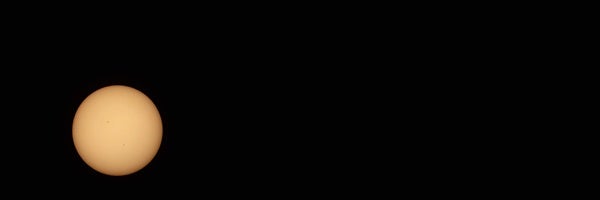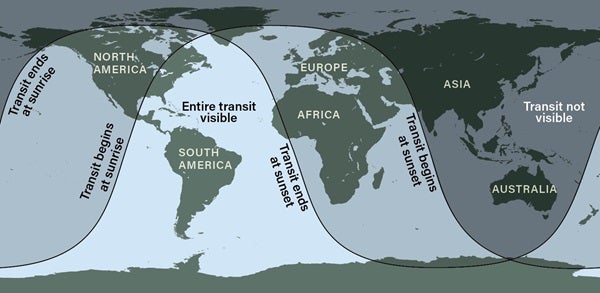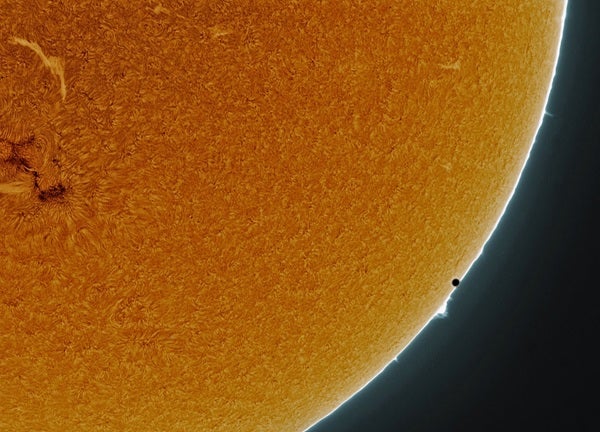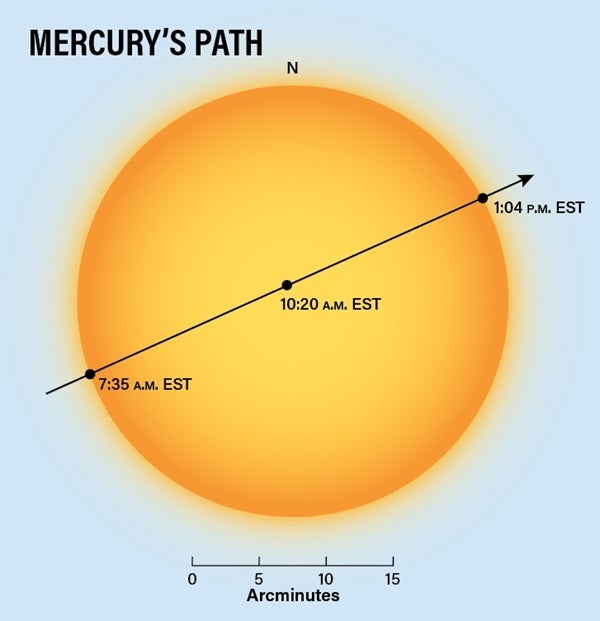Of all the bright planets, Mercury is the most difficult to observe. On November 11, weather permitting and using a solar filter, you can watch this planet cross the solar disk in daylight. This passage of one celestial body in front of another is called a transit.
Mercury orbits the Sun at an average distance of 36 million miles (58 million kilometers). Earth is nearly three times as far, so, from our perspective, Mercury always appears near the Sun. The planet takes 88 days (minus 45 minutes) to orbit our star. So, three — and occasionally four — times each year, Mercury passes between the Sun and Earth. On rare occasions — 13 or 14 times each century — we can see Mercury transit the Sun’s disk. That last happened May 9, 2016.
Here’s your chance to break out your safe solar viewing equipment from the 2017 solar eclipse, or create new innovative observing techniques to share with friends, family, and the community. But how do you turn a subtle astronomical event into a public spectacle and a teaching moment? This is your assignment.
Details
On November 11, Mercury begins its solar passage at 7:35:27 a.m. EST. Astronomers call this moment first contact. One minute 41 seconds later, at 7:37:08 a.m., Mercury’s entire disk appears against the Sun’s (second contact).
For the next 5 hours 25 minutes, the small black circle slowly crosses the brilliant solar sphere. Mid-transit occurs at 10:19:48 a.m. EST. At that moment, Mercury lies closest to the Sun’s center — a scant 1’15.9″ away. That’s close. (In fact, the next transit where it’s closer won’t happen until November 12, 2190, when the planet will pass only 9.1″ from the Sun’s center.)
At 1:02:33 p.m. EST, Mercury touches the Sun’s right edge, marking third contact. One minute 41 seconds later — at 1:04:14 p.m. EST (fourth contact) — the transit ends.
Note that Mercury crosses from left to right as our eyes would see it without the use of optics or through binoculars. Telescope optics, however, have several configurations, especially when you add a star diagonal. One might rotate the image 180°, another might change it right to left, and a third might do both. Before you head out to observe this event, know how your scope is going to present it so you’ll know where to look for first contact.
Viewing the event
Because Mercury spans only 10″ (1/194 the Sun’s diameter), the best way to follow its trek is through a properly filtered telescope. Choose an eyepiece whose magnification nearly fills the field of view with the Sun’s image. To select the right eyepiece, target the Moon near its Full phase. The Full Moon before the transit occurs October 13.
You can spot the planet against the Sun’s disk through filtered binoculars, but Mercury will appear tiny. In fact, at 7x or 10x, you’ll have trouble distinguishing it from a sunspot. Still, it’s better to watch the transit through binoculars than not at all. Just wait 10 minutes or so after first contact, and you’ll pick up the planet’s motion and direction.
Be sure to mount your binoculars on a tripod; otherwise, the involuntary motions of your hands will make the tiny planet even harder to spot. Another option is to use image-stabilized binoculars. Many observers use the image-stabilized Canon 18 by 50 model with good results.
Where it’s visible
At least part of this transit will be visible from most of our planet. The Americas, Europe, western Russia, Africa, New Zealand, and western Asia all are well-placed for the event. None of the transit will be visible from Japan, Indonesia, central and eastern Asia, or Australia.
In the United States, people in the Eastern time zone with clear skies will see the entire transit. Midwesterners will miss roughly the first hour of the transit. They, and observers further to the west, will see the Sun rise with Mercury already crossing its disk.
Sharing the transit
In 2016, staff and volunteers from the Cincinnati Observatory formulated a plan to publicize the previous transit. Inviting adults to play hooky from work to see a dot cross the Sun wasn’t reasonable. So, attention turned to schools
As the observatory began spreading the word, two obstacles appeared. The first was a lack of equipment. Most schools had neither a telescope that could sufficiently magnify the image of the Sun nor the safe solar filters to observe it.
The second obstacle was fear. In some cases, school administrators voiced concerns that they could not guarantee their students’ eye safety during the event.
Ultimately, the main obstacle to the campaign came on transit day: A cloud front covered the entire region within a 200-mile radius of the city.
Undaunted, the observatory will host another public event for this transit. You can find details at www.cincinnatiobservatory.org. But what if you’re nowhere near Cincinnati? No problem! You can set up a transit viewing station at your local school or library.
Because this transit occurs on Veterans Day, many people will have the day off from work and some schools will be closed. Lauren Worley, chief communications and engagement officer for the Cincinnati Public Schools, which are not in session November 11, plans to train teachers prior to the event.
There are several different ways of safely viewing the Sun that will work well for the transit of Mercury. If you own a telescope you could build an apparatus called a Sun funnel. A Sun funnel projects an image from the telescope’s eyepiece onto a screen. This allows many people to safely see the Sun at the same time, and it is inexpensive to make.
Leo Sack, the creator of various Sun funnels, said, “You can literally poke the image with your finger and say, ‘That dot is a storm on the Sun’s surface, and that little black circle over there is Mercury!’”
If you want to see the details on the Sun’s surface during the transit, there is no better view than through a telescope equipped with a Hydrogen-alpha filter. Such scopes show solar prominences that can wow a crowd unimpressed by Mercury’s diminutive appearance.
Don’t wait 13 years
Most people never have seen Mercury, so finding it in the morning or evening sky has its rewards. But to see the elusive inner planet during the day against the brilliant solar disk — that’s the kind of event observers live for. And remember, although the next transit of Mercury occurs November 13, 2032, that one will be entirely visible from only Africa, Europe, and India. The next one visible from North America isn’t until May 7, 2049. So, get out and see this one!













